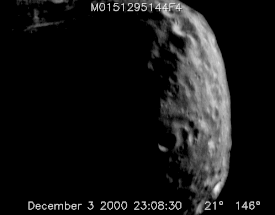Near-Earth object
|
||||||
A near-Earth object (NEO) is any small Solar System body whose orbit brings it into proximity with Earth. By definition, a solar system body is a NEO if its closest approach to the Sun (perihelion) is less than 1.3 astronomical unit (AU). NEOs include more than fourteen thousand near-Earth asteroids (NEAs), more than one hundred near-Earth comets (NECs), and a number of solar-orbiting spacecraft and meteoroids, large enough to be tracked in space before striking the Earth. It is now widely accepted that collisions in the past have had a significant role in shaping the geological and biological history of the Earth. NEOs have become of increased interest since the 1980s because of increased awareness of the potential danger some of the asteroids or comets pose, and mitigations are being researched. In January 2016, NASA announced the Planetary Defense Coordination Office to track NEOs larger than 30 to 50 meters in diameter and coordinate an effective threat response and mitigation effort.
NEAs have orbits that lie partly between 0.983 and 1.3 AU away from the Sun. When a NEA is detected it is submitted to the IAU's Minor Planet Center for cataloging. Some NEAs' orbits intersect that of Earth's so they pose a collision danger. The United States, European Union, and other nations are currently scanning for NEOs in an effort called Spaceguard.
In the United States and since 1998, NASA has a congressional mandate to catalogue all NEOs that are at least 1 kilometer wide, as the impact of such an object would be globally catastrophic. In 2006, it was estimated that 20% of the mandated objects had not yet been found. In 2011, largely as a result of NEOWISE, it was estimated that 93% of the NEAs larger than 1 km had been found and that only about 70 remained to be discovered. As of 5 February 2017[update], there have been 875 NEAs larger than 1 km discovered, of which 157 are potentially hazardous. The inventory is much less complete for smaller objects, which still have potential for large scale, though not global, damage.
...
Wikipedia




